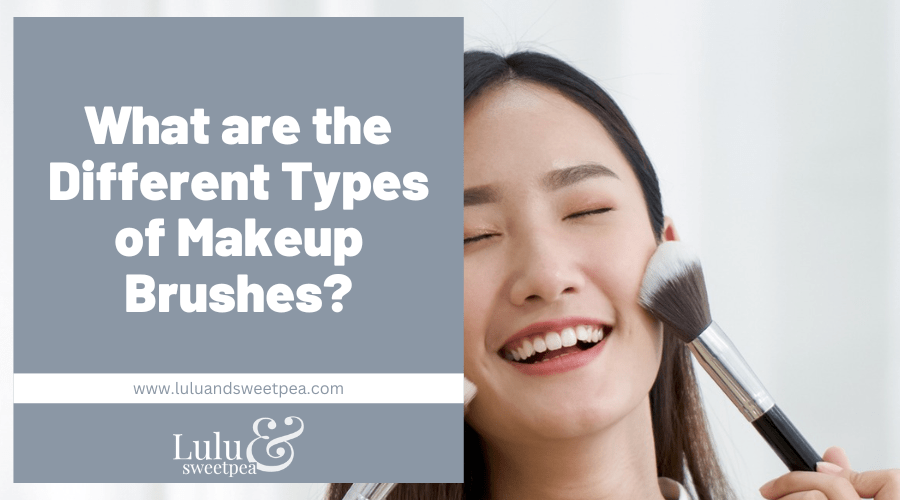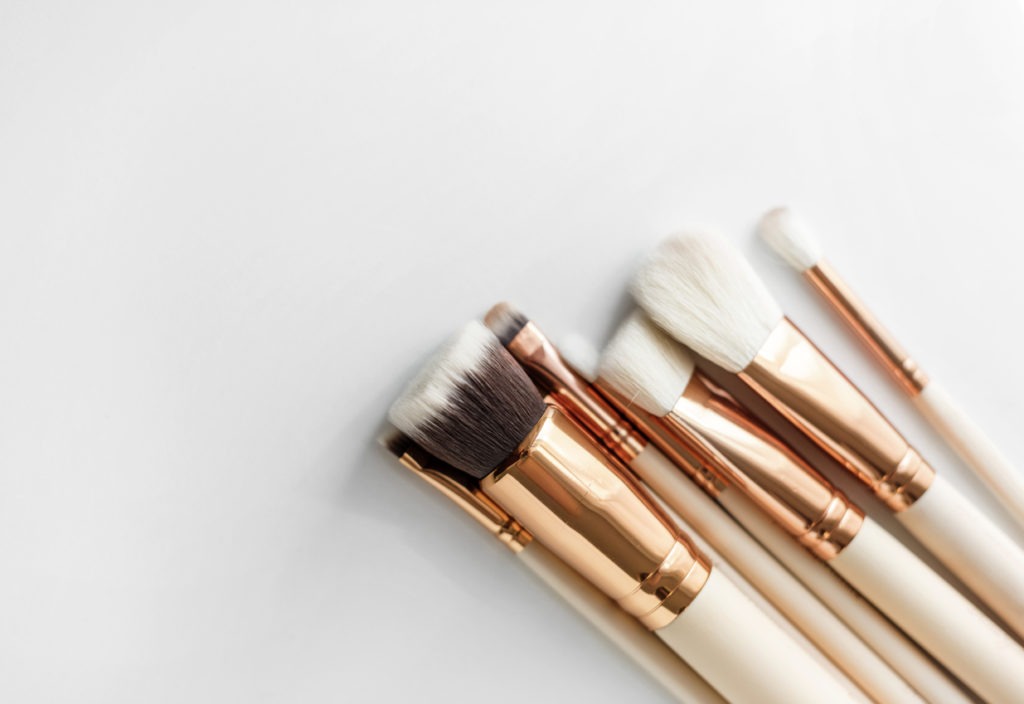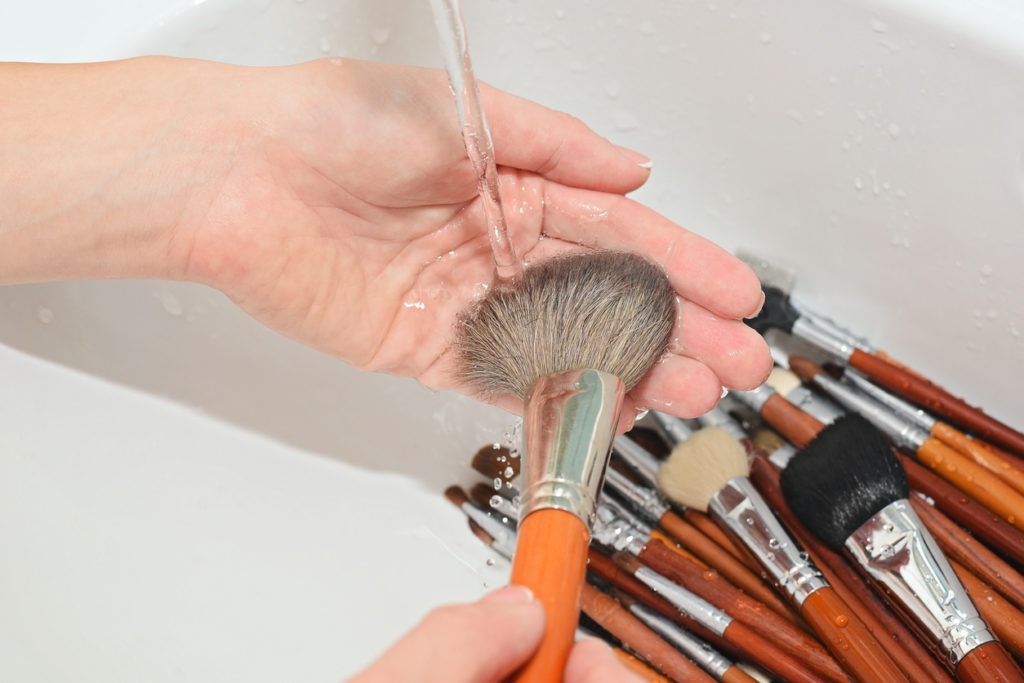Although math and makeup may not seem to go together, every look can be achieved by solving an equation: half the work is determining the ideal product formulations and shades, and the other half is choosing the appropriate brushes to apply them.
While selecting the right products is crucial, using a cosmetic brush made just for each product to apply it is the secret to attaining the result you want. So, if you’ve ever applied full-coverage foundation and ended up with a streaky or blotchy look, the brush you used may be to blame. The same is true for not being able to accurately draw a cat eye.
However, because there are so many options available, it can be difficult to determine which brush to use with a particular product. But don’t worry, we’re here to help you get familiar with the different types of makeup brushes and which brush to use in certain makeup products.
Why Use Makeup Brushes
Your final look after applying makeup will vary greatly depending on the tools you use in your application. Using the right brush, whether it’s a flat concealer brush or a tapered foundation blush brush, can transform how your makeup applies and help you achieve a smooth finish.
Before using your tool, you should also consider whether it is a natural or synthetic makeup brush. Natural hair makeup brushes are mainly made of animal hair and are best known for their blending and pick-up properties, whereas synthetic hair makeup brushes are made of man-made materials like nylon and are excellent for precise and streak-free application.
Different Types of Makeup Brushes and What They are For
When you’ve gathered a complete set of makeup brushes (and know how to use each one correctly), in the world of beauty, you’ve officially attained peak adulthood. However, not everyone has a personal beauty brush guide on hand, so if you’re still using your fingers to apply powder eye shadow, we understand. It might be difficult to know where to start when it comes to narrowing down your list of essential makeup brushes because of the multitude of foundation brush selections and the different types of bristles that are available.
For easier understanding, we have categorized makeup brushes into three: general face brushes, eye area brushes, and lip brushes. Bear with us as we enumerate and explain each makeup brush and what they are for.
General Face Brushes
1. Powder Brush
- Use: Gently applying a little layer of loose powder on your face.
- Guide: A powder brush is commonly a broad, full-fibered brush that can be used for a variety of beauty applications. It can be synthetic or natural. This widely used makeup brush is an essential item to have in your cosmetic kit. You can scarcely find a makeup set without one.
When applying foundation using a powder brush, dip it into the powdered product (this goes for both pressed and loose powders) and swirl it about or sweep it across your face until you get even coverage. Pro tip: Start in the center of your face and work your way out to ensure adequate application.
Because it’s so simple to blend and work your product in, this is a fantastic beginner multi-tool, especially for use as a mineral foundation brush.
When you want a more natural, less pigmented look, powder brushes are the best type of makeup brush to use for blush application. Instead of a dramatic, deep-hued appearance, visualize a dusting of rosy cheeks.
2. Tapered Foundation Brush
- Use: Precise foundation, highlight, or blush application.
- Guide: Tapered foundation brushes are often flat, less full in form, and with a gentle taper. These brushes work best with liquid makeup and other liquid cosmetics. To use, dip your brush in warm water and squeeze out the excess water gently.
Here, water serves two purposes: first, to ensure an even coat of foundation; second, to prevent the brush from absorbing any foundation, which will save you money because the brush won’t absorb any makeup.
Applying makeup with a foundation brush involves moving the brush in even strokes across your face. Make sure the makeup is evenly applied and that no harsh lines are visible. Again, it’s generally easier to begin in the center of your face and move outward from there.
Use your flat foundation brush to apply a little highlighter to your temples or to spot-correct; many makeup brush types are multi-purpose.
3. Stippling Brush
- Use: Achieving a flawless, airbrushed appearance.
- Guide: The fibers of a stippled brush have a distinctive appearance because they are of two different lengths. The majority of the brush is densely packed with long threads throughout. For layering different shades of makeup, stippling brushes work beautifully. With this kind of equipment, blush, foundation, and primer may be applied together without any issues.
Stippling brushes can be used with powders, but they work best with cream blush or liquid foundation. Apply cream foundation or blush by dabbing some on the back of your hand, then carefully dipping a brush into the product and stippling onto the face.
4. Kabuki Brush
- Use: Applying body shimmer or loose powder.
- Guide: The most striking-looking brushes are often kabuki brushes. Although they sometimes come in bigger sizes with densely packed fibers, you can also find smaller, travel-friendly kabuki brushes. They work best when applied to the body and face with loose powders.
Additionally excellent for blush and powder foundation are kabuki brushes. Apply the concentrated product carefully using broad, circular strokes after swirling the brush in the makeup and tapping off any excess.
Do you need to use finishing powder to set your makeup? Use a kabuki brush to apply the product evenly all over your face. Don’t press too hard to prevent distorting the placement of your blush, highlighter, etc.
5. Contour Brush
- Use: To achieve facial structure and sharp, accentuated cheekbones.
- Guide: Every beauty enthusiast should be able to contour, but it takes hard work to get good at it. What could go wrong if you were attempting a decent contour? Unblendable, dark streaks. You won’t ever leave the house in a two-toned nightmare, though, because we’ve got your back.
Purchasing a nice, angled contour brush is the first step; slanted brushes are preferred over flat brushes because they enable you to follow the natural contours of your face.
Choose your dark contour shade (this is the “shadow” that will contrast with the “highlight”) to achieve a contoured look. Generally speaking, you don’t want to go too dark, especially if you have fair skin. Stay with a medium tone but be warned that there won’t be contrast if it isn’t dark enough. You must discover the perfect fit.
You now have a darker contour shade. Let’s now map out your face.
Use the angled contour brush to outline the region along your hairline if you want to reduce the dimensionality of your forehead.
Next, make a pout with your face. Apply the darker shade with the contour brush to the hollow beneath your cheekbones, just below the apples of your cheeks.
Take the brush and draw parenthesis around your chin to make it appear smaller. Add some darker lines on either side of your jawbone, then finish. The darker contrast should now map out your face.
The final step is to blend everything. Although it seems straightforward, this is the trickiest and most important step in creating a contour that looks as natural as possible.
Use a powder brush, kabuki brush, or any full-fibered brush to blend.
The very last step is to use a highlighter, which can be applied with smaller brushes, on your cheekbones, forehead, nose, chin, and Cupid’s bow. For larger areas that need highlighting, use general powder brushes.
6. Silicon Blender
- Use: To evenly apply foundation and blend makeup products.
- Guide: The majority of silicone blenders are flat and oval or teardrop shaped. Using a silicone blender is fantastic because there is no possibility of product waste because it won’t be able to absorb anything.
To apply, dab foundation and stipple it all over your face, making sure to blend it into your neckline as well. Focus on short, staccato motions rather than swirling as you would with a typical brush because swirling with a silicone blender might result in smeared makeup. Tapping motions work best for a more natural look.
7. Beauty Blender
- Use: Applying concealer, highlighter, blush, and wet and dry foundation.
- Guide: The Beauty Blender is a favorite tool among makeup artists on YouTube. The Beauty Blender and other beauty sponges of a similar design are well-liked for a reason: they’re excellent for applying a wide range of products. It can be used in applying a primer for a uniform, sturdy base. You can even use it to apply topical creams or sunscreen. Normally, beauty enthusiasts use it most frequently to apply foundation and blend blush, bronzer, and highlighter.
Use the Beauty Blender’s tip for detail work on smaller places, such as applying highlighter to your cupid’s bow or shimmer to your brow bones.
If you’re using dry powder, all you have to do is pour some of the product onto the lid and dip the sponge right into it. Exactly the same steps as for liquid foundation should be followed. Be advised that the sponge may need to be re-moisturized since it can dry up during application.
If you’re already done with your makeup but you notice that it looks a bit patchy, use the side of the Beauty Blender and roll it across your entire face to blend in all areas of your face.
8. Fan Brush
- Use: Apply highlighter, remove makeup errors, and blend out dark lines.
- Guide: Unsurprisingly, a fan brush has a fan-like form. Due to their versatility, these cosmetic brushes are excellent essentials to have in your makeup toolkit.
They work amazingly well, for instance, as a mistake-corrector. Perhaps while applying a smokey eye, you got carried away with the eye shadow and now you look like a raccoon with pigment specks all over your face. Use the fan brush to gently remove these additional bits of pigment.
Use a fan to softly buff bronzer or highlighter over your cheekbones in sweeping motions.
Fan brushes can also be used to diffuse color. Reduce the intensity of a dark blush by fanning it.
Utilizing fan brushes as a lotion, sunscreen, or concealer applicator is an alternate use for them. You can use it to apply any type of skincare product in a delicate, relaxing manner. Apply your retinol cream like a genuine esthetician while using the fan brush to fan away all of your troubles while pretending you’re at a day spa.
9. Blush Brush
- Use: For the purpose of achieving that dewy, youthful rosiness when applying blush.
- Guide: Surprisingly, a blush brush resembles a powder brush. However, because blush brushes cover a smaller area than a powder brush, they tend to be a little bit stubbier. Avoid creating Raggedy-Ann-like red circles on your cheeks when applying blush. Apply blush on your cheek’s apples and distribute it outward to avoid the doll look. Test out the pigmentation on your wrist or the back of your hand with light pressure at first. Building color is much easier than removing it once it has been applied.
Eye Area Brushes
1. Eye Brow Brush
- Use: Applying general color in broad strokes to your eyelids.
- Guide: A short, typically stubby brush used for applying eye makeup all over the lid and upper eye area is called a general eye shadow brush. Additionally, this is a fantastic tool for eye shadow primer. Apply shadow to lids by dipping the brush into the product, tapping out any excess. You can wet the brush for a more pigmented result.
2. Angled Eye Shadow Brush
- Use: Used to blend and contour eye makeup.
- Guide: An angled eye makeup brush is the ideal accessory for beauty enthusiasts with more experience. Use it to line your crease with a contrasting color, to precisely smudge color into the corner of your eyes, and to add dramatic color.
3. Eye Shadow Crease Brush
- Use: To give the appearance of depth and to dramatically contrast with your base lid color.
- Guide: Generally speaking, eyeshadow crease brushes have a gentle taper, which enables precise application while adding the finishing touches to your smoky eye. Use it to layer pigment in the creases of the eyelids.
4. Eyeliner Brush
- Use: For applying liner to create a cat-eye or fuller lash line.
- Guide: Marilyn Monroe, Twiggy, and Brigitte Bardot all wore cat-eyes to create a glam, seductive look. An eyeliner brush has several uses. For your eyeliner, obviously, first and foremost. Apply eyeliner by dipping the brush into the pot (often, eyeliners will have brush integrated into the product). Draw a line from your inner eye outward, thickening the line as you go and flicking it out toward the ends.
As they say, practice makes perfect, and this is especially true when trying out different eyeliner techniques. Stable hands are essential for applying eyeliner (don’t do this after drinking three cups of coffee). It can be a good idea to take a selfie after applying eyeliner to check how identical your wings are.
Using the hash or dot technique is an excellent place to start if you want to improve your cat-eye skills. Make small hashes or dots with the eyeliner brush down your lash line, and then add a final dot where the wing’s tip will be. To achieve the ideal cat-eye, connect the dots.
To ensure that the angles of both your wings match, you can use a stencil or even tape if you really want to be precise.
5. Brow Brush
- Use: Used to groom and manage brows.
- Guide: The majority of brow brushes have a brush side and a comb side. Even brow kits that may be customized to any brow shade are available. A duo-brow brush can control even the most unruly brows.
To begin, shape and straighten your brows with the comb. Apply your brow product, whether it is a powder or a gel, using the brush side. Use short, staccato strokes, whether applying cream or powder, and ensure that the ends have a defined point. Also, keep in mind that your brows are sisters, not twins. Instead of forcing your brows into strange shapes, follow their natural contours. Take pride in the extra hair on your left side!
6. Mascara Wand
- Use: To coat your upper and lower lash lines in mascara.
- Guide: Mascara wands are essential tools that everyone should own. They help in defining and separating each lash. Use an eyelash curler before applying your mascara with the spoolie for an even more dramatic, complete look.
After curling your lashes, sweep up your mascara wand, being careful to squeegee extra product over the opening of the mascara tube to prevent getting it on your lashes. This will prevent spider lashes or an excessive amount of stickiness on your upper and lower lashes.
In a pinch, you can tame your wild brows by using a clean mascara wand.
Another piece of advice is to keep the mascara wand, clean it, and use it with a new formula if you love the mascara wand itself but not so much the formula.
Lip Brushes
1. Lip Brush
- Use: To precisely apply lip cosmetics such as lipstick, gloss, and others.
- Guide: Have you ever witnessed a child putting on lipstick? Usually, they’re just unsuccessfully attempting to apply lipstick someplace near their lips. Even as an adult, it might be challenging to remain in the lines when using the applicator that lip products already come with.
So you should get a lip brush to address this issue. Simply dip the brush into your lip product, then apply to your lips. Apply a liner of the same color to complete the appearance.
2. Lip Liner Brush
- Use: After applying the main lipstick or gloss, add lip liner.
- Guide: Lip liners, which are flat and tapered, assist complete your lip look. Line your lips precisely, cover flaws, and contour your mouth elegantly.
Cleansing
While we’re on the subject of makeup brushes, it’s crucial to monitor your routine to prevent infections, rashes, and other unpleasant side effects from using dirty brushes. Use a gentle cleanser or a brush-specific cleanser and moisten the bristles to wash your brushes and keep bacteria at bay (avoid getting water on the handles). Then, once the brush is clean, swirl it on a piece of paper or try using a makeup brush cleaning wipe. Rinse the brushes to make sure there is no remaining soap in them. To keep their shape, let the brushes air dry.
Conclusion
It can be challenging to figure out how to use makeup brushes, but the effort is definitely worth it. Your beauty game can be improved by using the right makeup brushes and understanding how to use them properly.


